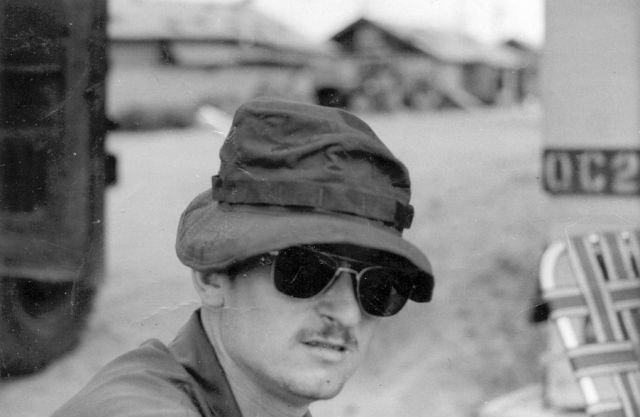
I
arrived to the unit (174th AHC, Duc Pho) about the 13th of Jan. 1970 (transferred from Germany).
At first, I was assigned to maintenance, but only stayed there for a few days- as I wasn’t very good
at repair work. I was asked if I wanted to be assigned to one of the Flight Platoons and I was
eager to be switched. I flew a couple of weeks as a Gunner, and I must admit that I wasn't very
good at that either. After a couple of combat assaults, I found out that I must have been the
worst Gunner in the unit. I had all kinds of problems with my M-60's. At that time, the Door
Gunner’s job was to take care of the two M-60's and the Crew Chiefs used these weapons
provided to them by said Gunner assigned to the aircraft. I will say that I worked hard to get
my weapons up to par with the other Gunners. Someone eventually came to my aid in showing
me how to repair and modify the M-60's, so they would be the best in the Unit. I wish I could
remember who it was that helped me, but I just do not recall.
After solving the
weapons problems, things started going much better. A slot for a Crew Chief came open and
it was offered to me and I took it. Little did I know; the slot was on the 11th Bde. Commander’s
ship. How I hated being the Crew Chief on that ship. It was so boring… Fly and sit down… Clean
the A/C and sit down… Fly somewhere else and sit down. The most boring assignment any Crew
Chief could have. Luckily, a new guy came in and he wanted the job, and I was more than happy
to give it to him. I was then assigned to Dolphin A/C #671 and flew on it until it crashed
(my first crash), and it was DX'd in April or May of 1970.
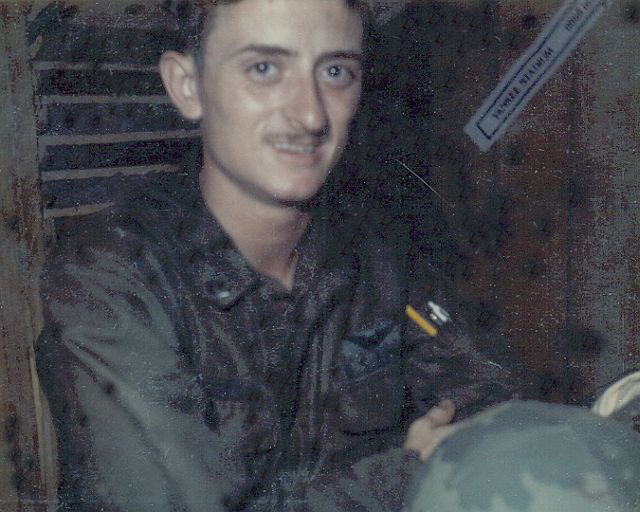
May 23rd, 1970 was day of rest because it was my birthday and I didn’t have to fly.
I had slept in, and had gone over to the ‘steam and cream’ to try and get cleaned up. For the most
part, the day had been very boring- as all the flight crews had been out on missions. In the early
afternoon, I was lying on my bed when someone from Operations came in and asked me if
I wanted to fly a LRRP mission. It was a way of easing the boredom, so I replied yes and asked
who my Gunner was. I remember the guy laughing and telling me it was a FNG by the name of
Barnhart (sp.?).
I hooked up with Barnhart and headed with him over to Armament (because
he was so ‘green’) to pick up M-60's. As Barnhart and I walked to Dolphin #644, I found out that
he truly was a FNG, and had only flown on helicopters a couple of times during his Gunner
training. So during the walk, I told him what he was to do if the aircraft was shot down, and what
I would be doing. Making sure that he knew to get the co-pilot out his side of the A/C, and to help
clear all other personnel out of the aircraft, and to maintain 'fire' if his side was 'hot' (so that the
others could ‘clear out’ of the safe side. When we got to the A/C, CPT Greg Smith and LT O’Neal
(Co-Pilot) were already ‘pre-flighting’, so Barnhart and I continued to talk and mounted the M-60's.
The LRRP's walked over to the flight line to meet us, and loaded up their gear inside the
A/C. It wasn't long until a pair of Shark Gunships came bouncing down toward us and we lifted off for
the LRRP's insertion (just took a couple of minutes). We were low leveling, out in the mountains, when our
aircraft topped the ridge and we turned down the valley to the right. We didn't realize that the Sharks
had turned up the valley to the left, but due to the fact we were flying faster than them, and at low
level, we thought they were right behind us.
Hell broke loose and we started taking
fire all around us. Our aircraft suddenly lost power and we were going down (and very hard).
We hit and slid through some trees and landed in a very small opening. Both the M-60's were firing as
the LRRP's cleared the A/C and started returning fire. I could hear the ‘May Day’ calls CPT
Smith was sending out as I cleared my seat and started toward the front of the A/C to help him
get out. As he got out, we started taking ground fire from the rear of the A/C and I stood by
his door returning fire with my M-16. He was trying to get word to the Gunships that we were
in big trouble, and needed help now. The Sharks showed up, and started making ‘gun runs’
all around us. I remember that during this time, I had a vision of my tombstone, and I could
clearly see the writing on it: William Ray Wilder, U.S. Army, May 23, 1948, died May 23, 1970.
It’s strange- the things you think of at times like that. The gun fire toward us stopped, and I
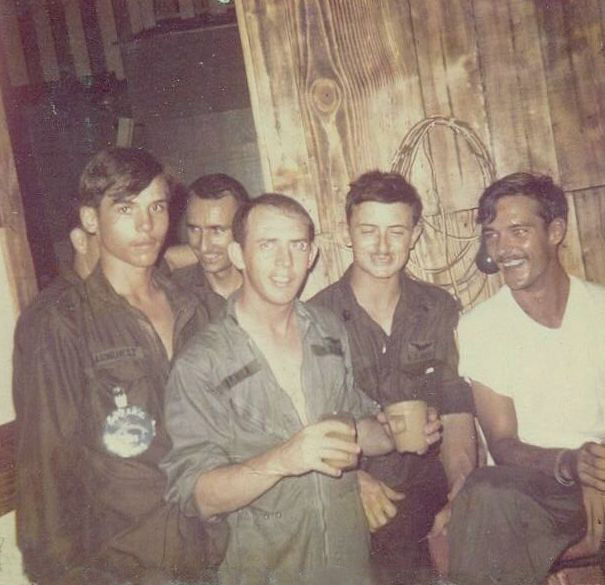 started to remove the radios from the aircraft. As I pulled out the last radio, I had stepped
backwards and fell into a creek that had been covered by brush and weeds. CPT Smith
reached his hand to me and pulled me back up. I’m not sure how long we where on the
ground, but it seemed like hours, waiting for a lift ship to come and get us. Finally it showed
up, but the clearing that we where in was too small for it to land. There was a clearing above
us, and that creek (which I had 'found' by mistake) led right to it. So we stepped down into
the creek and made our way up to the pick up. As we got to the clearing, aircraft were landing
and dropping off troops to secure the area and search it out. We happily boarded one of
the slicks and headed back to our home to Duc Pho. We partied hard that night, and all
the officers joined us. Little did I know that more crashes for me where to come. The photo below
left is of that party. Left to right are: PFC Barnhart (sp.?), CPT Smith, LT O'Neal, SP4 Wilder and CWO Dziadul.
started to remove the radios from the aircraft. As I pulled out the last radio, I had stepped
backwards and fell into a creek that had been covered by brush and weeds. CPT Smith
reached his hand to me and pulled me back up. I’m not sure how long we where on the
ground, but it seemed like hours, waiting for a lift ship to come and get us. Finally it showed
up, but the clearing that we where in was too small for it to land. There was a clearing above
us, and that creek (which I had 'found' by mistake) led right to it. So we stepped down into
the creek and made our way up to the pick up. As we got to the clearing, aircraft were landing
and dropping off troops to secure the area and search it out. We happily boarded one of
the slicks and headed back to our home to Duc Pho. We partied hard that night, and all
the officers joined us. Little did I know that more crashes for me where to come. The photo below
left is of that party. Left to right are: PFC Barnhart (sp.?), CPT Smith, LT O'Neal, SP4 Wilder and CWO Dziadul.
After that, I went back into the normal 2nd Flight Platoon. I flew with them for some time, and then
I remember that Major Blackburn asked me if I would 'crew' his ship. I took the assignment. I loved
flying with the Major, and I was his Crew Chief until sometime in the fall of 1970. I learned a lot from
him, and always tried to live up to his standards.
It was in his Aircraft, with CPT Alvord
and Mr. Thompson (I was Crew Chief), that I was shot down the third time.The Late Fred Thompson
stated: “On August 8, while flying as C&C on a combat assault, Captain Alvord and I got shot down
over the Battagan Peninsula in Major Fred Blackburn's brand new H-model #200. A total of ten pax
(passengers), including the crew (with the Major as Observer), walked away uninjured. Dolphin 200
was a complete loss as it
burned totally. Bill Wilder was the Crewchief, and he was the only casualty emotionally- as we
reassigned him a 'dog' aircraft as a replacement bird. It was the first of three 'shoot downs'
Wilder and I would survive together. We referred to each other as 'magnet ass' after that.”- Fred
Thompson 2000 (See:"A/C Dolphin #200
Down/Fred Thompson’s Bio")
I guess it was during this time that I started getting a reputation for doing a lot of crazy
things (i.e.: Getting prisoners by leaving the A/C, and/or going on missions that nobody else wanted).
I don't remember why, but I left the Major's ship and finished the year flying on another lift ship.
I extended my tour in Dec. of 70 and went home for 30 days.
CW2 ‘Rev’ Bob Black
This is my experience/story behind the shoot down of Primo Pilot CW2 Black. The Primo
Pilots (11th Infantry Brigade) were very close with the Sharks, as they often worked together. Mr.
Black was shot down in the river west of Quang Nai on 11 Jan 71. Efforts were made to recover
his body, but to no avail. I had left the unit for home (on leave) for Christmas, for I had just extended
another tour. After coming back to the unit in early Jan of 71, I was still flying as Crew Chief on a
Dolphin ship. I had not been back but a day or so, when Mr. Black’s body was spotted in the river.
My ship was assigned to drop off some Engineers and a rubber boat so they could
recover his body (12 Jan 1971). While they were doing that, my ship was doing re-supply missions
in the area. Several hours later, we returned and picked up Mr. Black's body and flew it to Duc Pho.
Sometime after we dropped off Mr. Black's body, all aircraft were called in for dust offs and to put
troops in south of Duc Pho- as a convoy had been hit on QL 1. My aircraft joined other Dolphins
and Sharks to support the troops in this convoy. After this mission was over, we were headed back
to Duc Pho. My pilot called OPS and asked about the Engineers, and we were told they had been
picked up earlier by aircraft from another unit. Night had fully ‘set in’ by this time and we were
eager to get back to Duc Pho for food and rest- as we had been out all day.
As we
neared Duc Pho, a distress call was picked up from the Engineers. They were still in the river
and had been hit and one was missing. Two Sharks and my aircraft headed back to the river,
while another Dolphin aircraft fueled and had flares loaded into it. We got to the river and couldn't find the engineers, so the pilot flew slow and low over the river.
Finally the rubber boat was spotted. As we neared it, I saw two men on the south side of the
river; two of the Engineers. We landed next to them. One of them had been shot in the leg. The
Sharks where flying cover for us and the flareship had started dropping the flares. As we loaded
the Engineers, one of them informed us that their SGT was wounded and was up stream about 75
to 100 yards from where we were. He really wasn't sure just exactly where the SGT was.
We decided that it was best that I looked on the foot. I got the Co-Pilot’s 45 and started trotting
up stream in the darkness. I knew that if he was wounded, that an M-16 would just be in my way if I needed to carry or
assist him. I also took several smoke grenades with me, so if I did take fire, I could mark my position.
In addition, I had the small survival radio. As I got up stream about 70 yards, I found the SGT lying on the
side of the path. All I could think of was getting him and me back to my aircraft, so I picked him up
and carried him some distance, but he was too heavy for me to carry. I 'popped smoke' and my
pilot landed the aircraft very close, and we loaded the SGT on board.
We lifted off, and it was at that time I realized the SGT was dead. We headed to Chu Lai hospital- as
we were leaving the Sharks firing rockets at the rubber boat to destroy it. I believe this was my last
mission as a Dolphin crew chief. While at Quang Tri, I happened to run into one of the Engineers and
he remembered me.
Again, after getting back to Vietnam from leave, I stayed with the 2nd Flight Platoon
until just before
the entire Unit moved north (Quang Tri) for Lam Son 719 (Laos), in the last week of January 1971. I
was assigned to Shark Gunship UH-1C #65-09470 (Photo below is Shark #470 'socked in' at Khe Sahn 1971. All
unidentified- except me, second from left and Chuck Blake second from right) just a few days before we left. What a sorry looking piece of
junk.
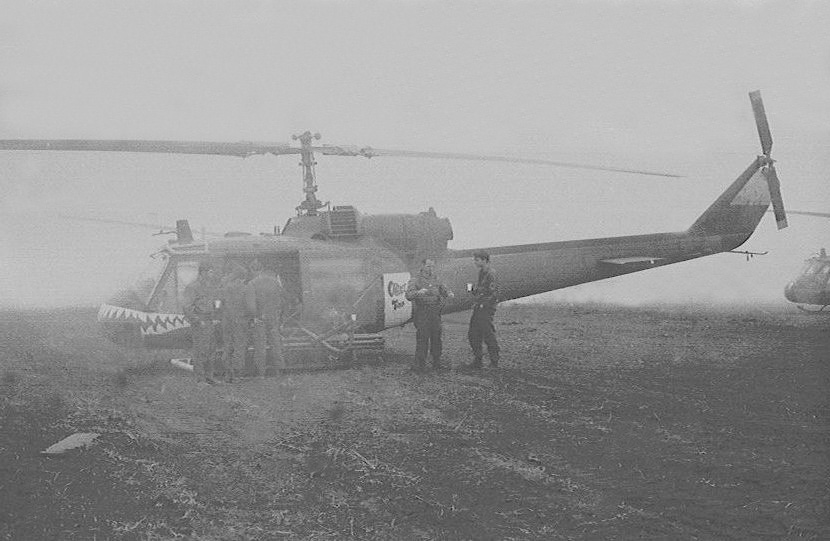
She had so many colors on her and had patches everywhere. I think I counted over 25 bullet
hole patches on her. But I was so proud to be a Shark, and I knew that this Gunship would be mine,
and I would be proud of it in time. They put her at the back of the rest of the Shark Gunships
because she was so ugly, but that was OK. She was mine. We painted ‘Charlie Tuna’ on the rear
access panels, because she was ‘Sorry Charlie’ and had a weak engine. During Lam Son 719 (first
week of Feb. to first week of April 1971), I flew a lot of Shark missions, but also flew on the lift ships (Dolphins).
After Lam Son 719, the entire Unit moved to Chu Lai (April 7th 1971), and it was then that
I extended for a third tour. I left country for my 30 day leave in May. While on leave, I got married, and
then returned to the unit in early June. The unit was very short of personnel at that time and
sometime in Aug. or Sept., I became Shark 60. During the third week of Oct., I got message from
the Red Cross stating that was I needed home stateside. I left for a two week leave, but when I started back
to Vietnam, I found out the 174th AHC was ‘standing down’, so the Army assigned me to a Cav
Unit in Da Nang. I didn’t like the idea of being with a Cav Unit, and luck has it that I was able chose
to stay stateside. I was never again able to see anyone from the 174th AHC until 2005.
Lam Son 719
 Thinking about Lam Son 719, I won’t share
my entire story. I was very busy at the time (smile). First, I had just become a Shark Crew Chief. I already
mentioned my Shark Gunship #470. I guess I took great care of her. That stubborn old bird lasted
until Unit 'Stand-Down' too, only
it was renamed 'Ace of Spades II' and sported a completely different set of Shark teeth that were painted
on her (photo below in mid 1971 Chu Lai. L-R: Pilots PJ Roths and Bennie Holmes).
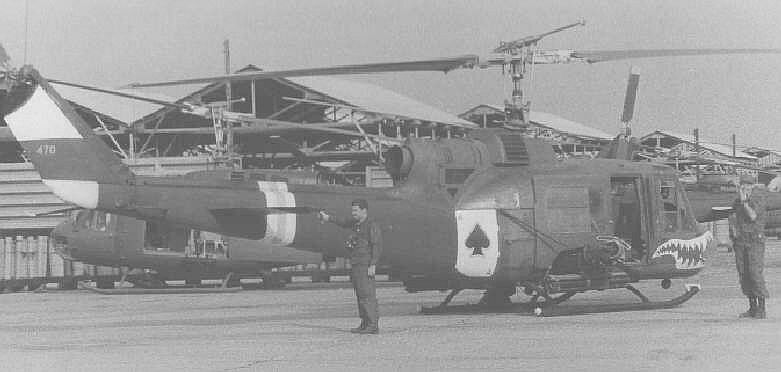
And...
I was ‘on the ground’ (crashed/shot down) five times while in Laos
(four times with the Sharks and once with the Dolphin lift ships). As many know, I was with Fred
Thompson when Marshall was shot down and we had landed to try and help (See:"Medevac Rescue of Surfer’s Crew”). I was with the
Shark team when they landed on the knoll trying to return for fuel (See:"Shark Team Lost In Laos”
). I was ‘on the ground’ on the 3rd and 5th of March (both days) 1971, when the Sharks where
shot down (See:"Two Shark Teams Down In
Three Days”). And then, of course, I was with Fred Thompson when he took a enemy round
in the helmet (24 Feb 1971). That wasn't pretty. We were flying Shark #470.
(See:"Fred Thompson’s Bio: ‘Head Shot’").
And one time as crew chief on a lift ship
picking up wounded, I was again 'on the ground' in Laos. Don't tell anybody about all this,
because it was forbidden by Richard M. Nixon for an American soldier to set foot in Laos.
Lam Son 719, in
my opinion, was the beginning of the end for the
174th AHC- for everything changed from that point on. We just didn't realize it. Like many other
Airmobility Units, our ships couldn't fight with that intensity. Not enough ammo, fuel and engine
power. Flying at tree top level was asking to be shot down. At normal height for ‘gun runs’, we were
sitting ducks for the 51's and small arms fire. At higher altitudes, our fuel ran out too fast to stay on
station very long.
All the pilots where fearless, but they also soon realized that we were
not prepared for this type of fighting. It wasn't long before the turn over rate of personnel also
began to hurt the Unit. Always before, there was time to break in the FNGs and learn about them,
but this it was different. You could show up at your A/C and fly with someone you had never seen before.
Pure exhaustion could be seen in the eyes of everyone there. There was no rest, just one mission
after another... and then another. There where days that went by, and then you would learn of a friend
that was lost or gone. Just more FNGs in their place. I know that only a handful of the people that
left Duc Pho as crew members or pilots actually came back with the Unit (in Chu Lai).
Don't remember
eating much food then, other than C-rations. And many nights I was too exhausted to eat, even if there
was food. All I remember is wanting to sleep. I am so very proud of the men that flew during that time,
and even to this day I wonder how we were able to survive. The skill of the pilots, their flying
abilities, to adjust to the conditions and the shear courage it took just to get into the aircraft for
the missions was amazing. The crew members that took the long walks to the A/C knowing that, not only their
life, but the lives of the other crew members was dependent on their skills and weapons.
This much I do know: A lot of the airmobility tactics that are used after 1971, came from the mistakes learned
during Lam Son 719. And one thing that I would like to know: I flew every day, either on Shark Gunships
or on the Dolphin lift ships. I realize that we were short of personnel, but I don't know of any
others (Crew Chiefs and/or Door gunners) that did this. Can anyone offer comment/help on that?
Note: The information here was provided during the May 2006 174th AHC Reunion, and thru e-mail afterwards. We finally found
Bill through the Internet in 2005. Bill is a true Patriot, and was exemplary during
his tours in Vietnam. He was awarded several medals and commendations including; The
Distinguished Flying Cross, two Bronze Stars, three Air Medals (two with Valor devices), two
Purple Hearts, two Army Commendation Medals (one with Valor Device), RVN Service Award
(with four Campaign Credits), the Viet Nam Campaign Medal, two RVN Gallantry Crosses
w/Bronze Stars, and the RVN Giay Chung Nhan (a medal awarded by the Republic of Vietnam).
He was very popular amoung his 174th AHC companions, and so very much so still today!. Thank you Bill Wilder for sharing some
of your story with us.
Below is a photo of Bill in 2005 with his custom Bike.
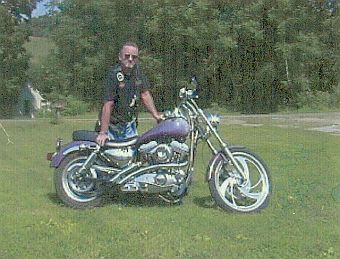
|




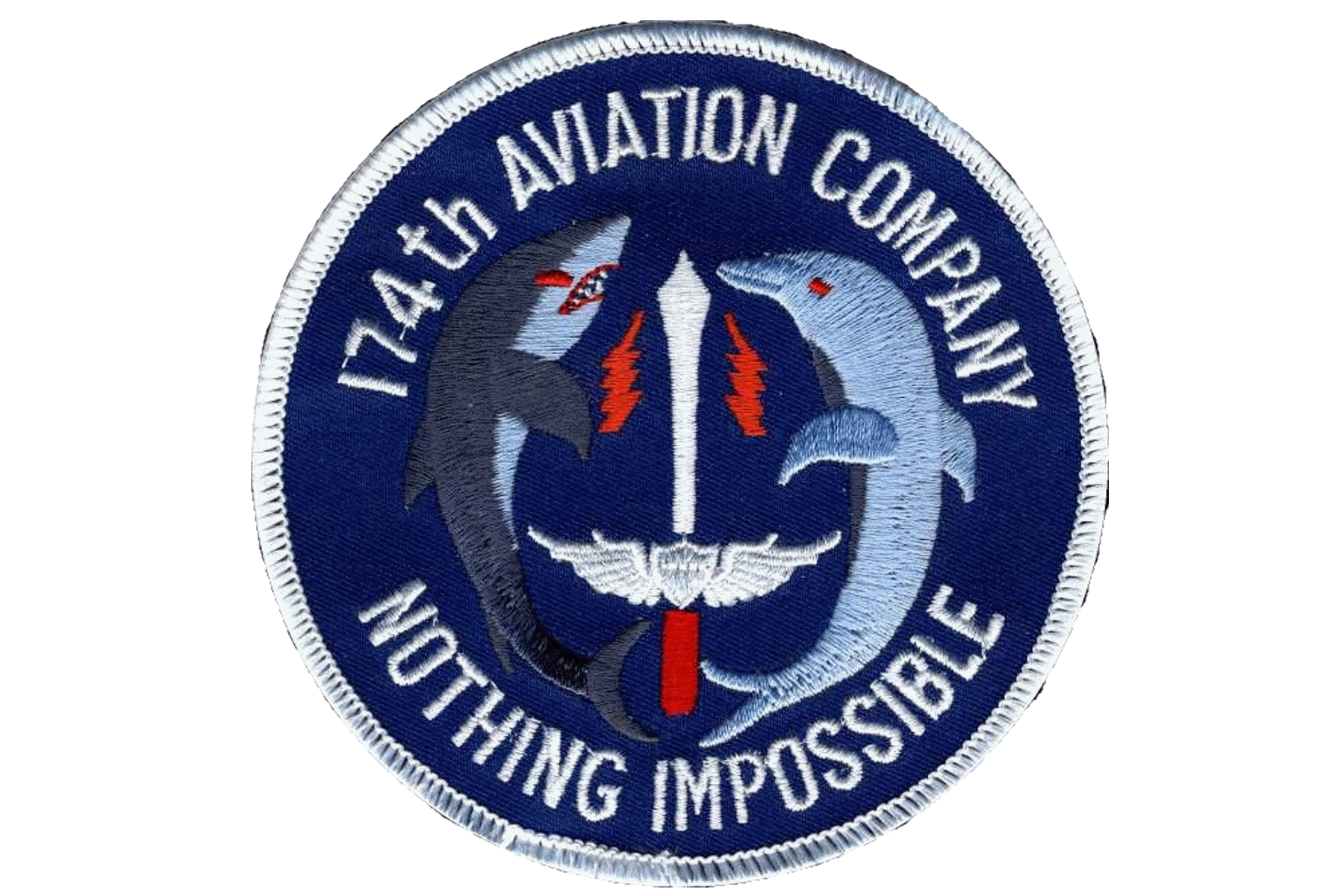
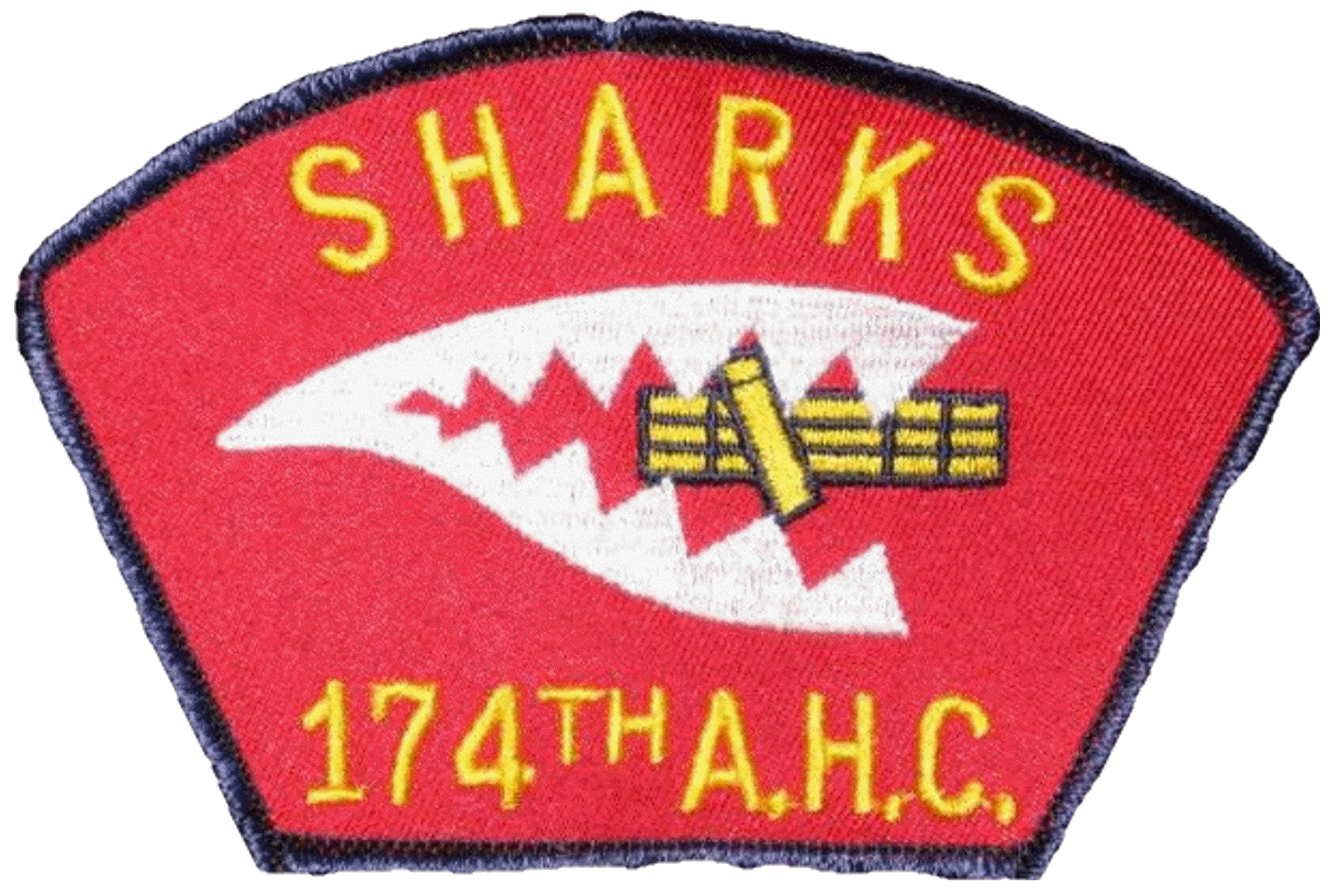


 started to remove the radios from the aircraft. As I pulled out the last radio, I had stepped
backwards and fell into a creek that had been covered by brush and weeds. CPT Smith
reached his hand to me and pulled me back up. I’m not sure how long we where on the
ground, but it seemed like hours, waiting for a lift ship to come and get us. Finally it showed
up, but the clearing that we where in was too small for it to land. There was a clearing above
us, and that creek (which I had 'found' by mistake) led right to it. So we stepped down into
the creek and made our way up to the pick up. As we got to the clearing, aircraft were landing
and dropping off troops to secure the area and search it out. We happily boarded one of
the slicks and headed back to our home to Duc Pho. We partied hard that night, and all
the officers joined us. Little did I know that more crashes for me where to come. The photo below
left is of that party. Left to right are: PFC Barnhart (sp.?), CPT Smith, LT O'Neal, SP4 Wilder and CWO Dziadul.
started to remove the radios from the aircraft. As I pulled out the last radio, I had stepped
backwards and fell into a creek that had been covered by brush and weeds. CPT Smith
reached his hand to me and pulled me back up. I’m not sure how long we where on the
ground, but it seemed like hours, waiting for a lift ship to come and get us. Finally it showed
up, but the clearing that we where in was too small for it to land. There was a clearing above
us, and that creek (which I had 'found' by mistake) led right to it. So we stepped down into
the creek and made our way up to the pick up. As we got to the clearing, aircraft were landing
and dropping off troops to secure the area and search it out. We happily boarded one of
the slicks and headed back to our home to Duc Pho. We partied hard that night, and all
the officers joined us. Little did I know that more crashes for me where to come. The photo below
left is of that party. Left to right are: PFC Barnhart (sp.?), CPT Smith, LT O'Neal, SP4 Wilder and CWO Dziadul.